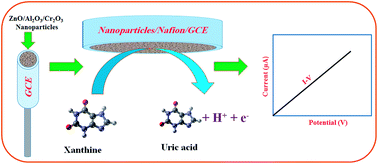Wet-chemically prepared low-dimensional ZnO/Al2O3/Cr2O3 nanoparticles for xanthine sensor development using an electrochemical method†
Abstract
A reliable xanthine (XNT) chemical sensor was fabricated using a facile wet-chemical method (by co-precipitation) to prepare ZnO/Al2O3/Cr2O3 nanoparticles (NPs) in an alkaline medium at low temperature. Powder X-ray diffraction (XRD), X-ray photoelectron spectroscopy (XPS), field emission scanning electron microscopy (FESEM), energy-dispersive X-ray spectroscopy (EDS), Fourier transform infrared spectroscopy (FTIR) and ultraviolet-visible spectroscopy (UV-vis) were implemented for detailed characterization of the NPs. To fabricate the working electrode as a XNT chemical sensor probe, a glassy carbon electrode (GCE) with a 0.0316 cm2 surface area was coated with an ethanolic slurry of the prepared ZnO/Al2O3/Cr2O3 NPs to make a thin layer and used to analyse XNT in a phosphate buffer system. To evaluate the analytical performances of the XNT chemical sensor, the calibration curve of XNT was plotted as the relationship of current versus the concentration of XNT. The plotted calibration curve was found to be linear over the LDR (linear dynamic range) of 0.05 nM to 5.0 μM. The assembled XNT electrochemical sensor exhibited the highest sensitivity (70.8861 μA μM−1 cm−2), the lowest detection limit (1.34 ± 0.07 pM), good reproducibility performance with high accuracy and long-term stability with standard results under ambient conditions. This is a simple route to selectively detect XNT with wet-chemically prepared co-doped ZnO/Al2O3/Cr2O3 nanomaterials using a reliable electrochemical method at a large scale for safety within healthcare fields.

- This article is part of the themed collection: Sensors for health and happiness


 Please wait while we load your content...
Please wait while we load your content...